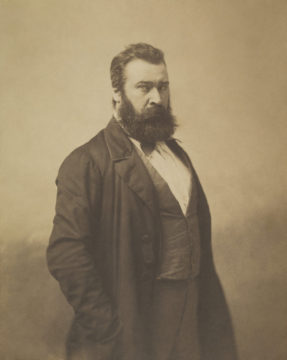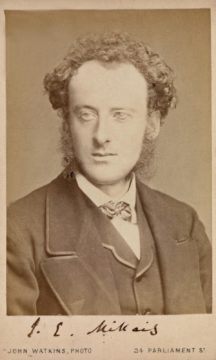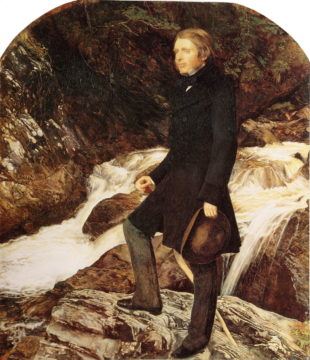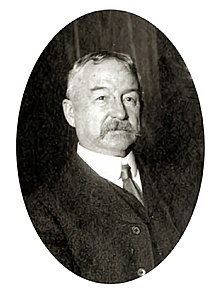by Eric Bies
 Jean-François Millet, a Frenchman, frowned beneath his full beard as he lay dying in Barbizon. It was 1875, and he was not to be confused with Claude Monet—not yet—who would later paint water lilies and haystacks but wasn’t, in 1875, rich and famous; on the contrary—and in spite of Édouard Manet’s having just painted him painting from the vantage of a covered paddle boat, appearing pretty well-to-do in the process—he was barely getting by. Meanwhile, Millet had already painted some haystacks. And though the stubbier English word his name renovates—the one that rhymes with skillet—happens to be a grain that is rather good for making hay, painters have tended to tend toward other stock. The snow-capped haystacks that we see in Grant Wood, for instance, were in all likelihood made with the same Midwestern alfalfa Verlyn Klinkenborg celebrates and dissects in Making Hay. We know that van Gogh painted a golden haystack or two—probably of wheat—and though the Vermeer Corporation of Pella, Iowa is one of the market leaders in modern hay baling technology, the closest the Dutchman Johannes ever came to a haystack was when he ensconced a common milkmaid in the daylight of a well-windowed kitchen.
Jean-François Millet, a Frenchman, frowned beneath his full beard as he lay dying in Barbizon. It was 1875, and he was not to be confused with Claude Monet—not yet—who would later paint water lilies and haystacks but wasn’t, in 1875, rich and famous; on the contrary—and in spite of Édouard Manet’s having just painted him painting from the vantage of a covered paddle boat, appearing pretty well-to-do in the process—he was barely getting by. Meanwhile, Millet had already painted some haystacks. And though the stubbier English word his name renovates—the one that rhymes with skillet—happens to be a grain that is rather good for making hay, painters have tended to tend toward other stock. The snow-capped haystacks that we see in Grant Wood, for instance, were in all likelihood made with the same Midwestern alfalfa Verlyn Klinkenborg celebrates and dissects in Making Hay. We know that van Gogh painted a golden haystack or two—probably of wheat—and though the Vermeer Corporation of Pella, Iowa is one of the market leaders in modern hay baling technology, the closest the Dutchman Johannes ever came to a haystack was when he ensconced a common milkmaid in the daylight of a well-windowed kitchen.
Whose haystacks won out? It was only a matter of time for Monet. By now his station in the popular imagination has practically eclipsed those of Millet, Wood, and Vermeer, if not van Gogh. We recognize his water lilies as readily as Picasso’s women, Warhol’s soup cans, and, lately, Kusama’s spotted tentacles. It is true that Millet’s Angelus, an apotheosis of peasant soil, shattered art-market records in 1890, exchanging hands Atlanticly for an astonishing 750,000 French francs. Yet the work itself has gradually absconded into what relative obscurity remains feasible for a canvas hanging in the Musée d’Orsay.
 In 1896, Death came knocking again—this time at John Everett Millais’ place in Kensington, London. Three hundred miles away in the Lake District, John Ruskin, arguably the most prominent writer in the English-speaking world, was sitting down in his study at Brantwood. He had begun and was beginning again upon the task of fishing his memoirs up from the murk of nervous senility. Praeterita, the title under which the work was published when all was said and done, is remarkable for how little it says and does to shed light on the life of its subject: it fails totally and completely, for instance, to mention Millais—the man who ran away with Ruskin’s wife, Effie. Neither is there a single reference to Pre-Raphaelitism, the radical Victorian arts movement whose young practitioners, Millais foremost among them, were ushered through the controversy attending their pictures (one of the boy Christ figured, well, realistically, bearing playground scrapes, a proper Pig-Pen) and thrust into stardom by the positive critical appraisal of, yes, Ruskin.
In 1896, Death came knocking again—this time at John Everett Millais’ place in Kensington, London. Three hundred miles away in the Lake District, John Ruskin, arguably the most prominent writer in the English-speaking world, was sitting down in his study at Brantwood. He had begun and was beginning again upon the task of fishing his memoirs up from the murk of nervous senility. Praeterita, the title under which the work was published when all was said and done, is remarkable for how little it says and does to shed light on the life of its subject: it fails totally and completely, for instance, to mention Millais—the man who ran away with Ruskin’s wife, Effie. Neither is there a single reference to Pre-Raphaelitism, the radical Victorian arts movement whose young practitioners, Millais foremost among them, were ushered through the controversy attending their pictures (one of the boy Christ figured, well, realistically, bearing playground scrapes, a proper Pig-Pen) and thrust into stardom by the positive critical appraisal of, yes, Ruskin.
John Berger—our anti-Ruskin, who died in 2017 and refused to write an autobiography—took many opportunities, if not explicitly to advise against it, then to suggest the impossibility of the genre. On one occasion (televised, sitting across from Susan Sontag) he went so far as to propose a singular and necessary condition for all life stories: death! A life must first come to its close, he argued, before it can offer itself up as a text. The writer then “reads” the life, and the story that steps forth, if it can, rises from the depths of its subject’s grave.
When, in his early forties, François-René de Chateaubriand embarked upon the undertaking of his own memoirs, he arrived at an extremely sane title—My Memories of Life—to fly on the flag above them. The project would gradually fill up his writing life, obsessively and sporadically, for the next forty years. It was fairly late in the gestational process of expansion and revision that he decided to unite the memories of his life and times under the more memorable title of Memoirs from Beyond the Grave. We can wonder what Ruskin might have revealed about Ruskin had he taken up the autobiographical task at, say, forty-five rather than seventy-five. But even if he failed to write about vital personal and interpersonal experiences with any consistency, he did make a point of sitting down and setting down his own face in charcoal, ink, and paints. Today, we can read this rich continuum of self-portraiture as a kind of pictorial autobiography.
 And we can add to it the pictures of others. In what is perhaps his most awkward achievement, Millais himself painted a portrait of the redly whiskered Ruskin. It hangs in the Ashmolean at Oxford, party to a golden burst of Pre-Raphaelitism. Surrounded by the works of Millais, William Holman Hunt, and Charles Allston Collins, among others, this Ruskin surveys them as much as he is survived by them, creations whose very cachet is part and parcel of his courage, way back when, to stand up for them. In the portrait by Millais, Ruskin is standing on a rock beside a stream. He appears to be close to smiling (where else can we find Ruskin smiling?), his mind elsewhere, eyeing the middle distance. Considering that it hasn’t been especially long since his wife jumped ship to join the man who is, begrudgingly but masterfully, painting him, he looks pretty serene.
And we can add to it the pictures of others. In what is perhaps his most awkward achievement, Millais himself painted a portrait of the redly whiskered Ruskin. It hangs in the Ashmolean at Oxford, party to a golden burst of Pre-Raphaelitism. Surrounded by the works of Millais, William Holman Hunt, and Charles Allston Collins, among others, this Ruskin surveys them as much as he is survived by them, creations whose very cachet is part and parcel of his courage, way back when, to stand up for them. In the portrait by Millais, Ruskin is standing on a rock beside a stream. He appears to be close to smiling (where else can we find Ruskin smiling?), his mind elsewhere, eyeing the middle distance. Considering that it hasn’t been especially long since his wife jumped ship to join the man who is, begrudgingly but masterfully, painting him, he looks pretty serene.
In 1907, at the age of sixty-nine, the American historian Henry Adams published his own Praeterita. Privately printed and circulated among close friends, The Education of Henry Adams brought its first readers back through the better part of the nineteenth century, from auspicious and dynastic beginnings through civil war to the blast of scientific invention at the turn of the century. In 1998, Modern Library named The Education the best nonfiction book published since 1900. And the book is great—not because but in spite of the fact that, like Ruskin’s, it omits an abyss. In Adams’ case, it was his wife’s suicide. (Her name—Clover—is nowhere to be found across the book’s 174,000 words.)
Like Ruskin, Adams never remarried. Instead, he traveled. He looked at a lot of art in Europe; he attended dinner parties in Washington; he hopelessly pined for a married woman many years his younger. In 1912, he made preparations for a visit to England. The ship he planned to board in New York City would never arrive.
 On the other side of the Atlantic, the American painter Francis Davis Millet was striding across the deck of the RMS Titanic. He had boarded alongside the other paying passengers who crowded the harbor in Cherbourg that evening. Now he was taking it all in. If something like jubilant expectation hovered on the air, threading itself between the four enormous smokestacks towering above him, there was also the strained anticipation that had nipped at the ankles and ears of every mass departure, from Exodus onward. For the time being, it was Millet’s good fortune to take his berth in the comfort of a first-class cabin. Goodness knows he had the means. A successful artist at home and abroad, his portrait subjects alone had included such worthies as Charles Francis Adams (Henry’s brother) and Mark Twain (who, curiously, wrote a comedy about the other Millet and called it Is He Dead?).
On the other side of the Atlantic, the American painter Francis Davis Millet was striding across the deck of the RMS Titanic. He had boarded alongside the other paying passengers who crowded the harbor in Cherbourg that evening. Now he was taking it all in. If something like jubilant expectation hovered on the air, threading itself between the four enormous smokestacks towering above him, there was also the strained anticipation that had nipped at the ankles and ears of every mass departure, from Exodus onward. For the time being, it was Millet’s good fortune to take his berth in the comfort of a first-class cabin. Goodness knows he had the means. A successful artist at home and abroad, his portrait subjects alone had included such worthies as Charles Francis Adams (Henry’s brother) and Mark Twain (who, curiously, wrote a comedy about the other Millet and called it Is He Dead?).
Frank, as his friends called him, was accompanied on board by one Archibald Butt, an Army Major and political advisor to the Taft administration (and, some have hypothesized, Millet’s romantic partner). On the fourth day of their journey, the Titanic struck a mountain of ice in the North Atlantic, punching a hole in the starboard side. Millet and Butt, who had been enjoying a round of after-dinner cards in the smoking lounge, were thrown from their seats. It was 11:40pm, and, from the get-go, the hole-punched starboard side was swallowing seawater at an alarming rate.
When news of the disaster finally reached him, President Taft sensed immediately that the worst had befallen his aide. “After I heard that part of the ship’s company had gone down,” he wrote, “I gave up hope for the rescue of Major Butt, unless by accident. I knew that he would certainly remain on the ship’s deck until every duty had been performed and every sacrifice made that properly fell on one charged, as he would feel himself charged, with responsibility for the rescue of others.” It has been reported elsewhere that Millet went down alongside him. They made themselves helpful until the very end.
On July 20, 1688, Matsuo Kinsaku showed face at a renga party. Renga, a form of collaborative artmaking, is something akin to the “exquisite corpse” enacted on social occasions by last century’s Surrealists. Kinsaku—also known as Basho, the grandmaster of haiku—was no stranger to the genre, an improvisational process that involved multiple hands in the composition of a single poem. In fact, we have evidence that he wrote the following lines as he sat among the other poets that evening, building up a literature:
millet among millet
nothing is scanty here
in a thatched hut
